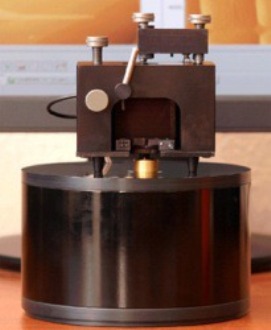Russian researchers formulated a new nanolithography method for carbon-based materials.
 Scanning probe microscope FemtoScan
Scanning probe microscope FemtoScan
This new method involves anodic oxidation of carbon-based materials using an atomic force microscope’s probe. Researchers are exploring the use of atomic sharp probes for observing different surfaces. Such probes are like fingers that can come into contact with several objects. Advanced hardware equipment detects precisely the minute actions of a probe along the surface, thus producing images of the nano-world.
Scanning can be conducted in all environments such as air and liquid and do not require the use of costly vacuum devices such as ion or electron microscopy. Probe microscopes are usually compact and can be easily used with other equipment and offer a range of additional capabilities.
For instance, molecules present in the environment can be made to react with surface atoms by applying a voltage between the surface of the object and the probe due to which the surface acquires positive charge, followed by a local anodic oxidation. Surface atoms get oxidized due to electrochemical reaction. When a carbon-based material undergoes anodic oxidation, cavities are formed on the probe. This is because carbon atoms react with oxygen. However, additional experiment confirmed that water, present on the surface from the air, was the main oxidizer.
Researchers discovered that graphite oxidation results in the formation of cavities as well as mounts. Graphite oxide has the same stratified arrangement as graphite, but layers of carbon atoms get affected due to the newly formed bonds. Water molecules also enter into the gap between layers, which form mounts.
Local oxidation of graphite oxide’s surface can form several nanostructures with possible applications in electronics, in manufacturing of biological and chemical sensors, and plates for experiments featuring individual living cells. The method allows the generation of nanostructures up to 10 nm resolution within several minutes.